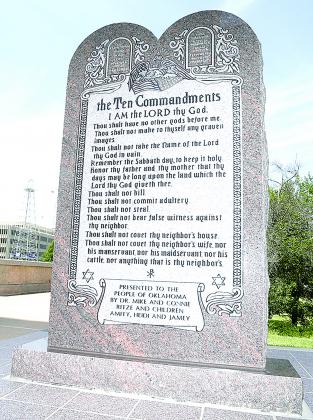Magistrate Darrin Gregg brought the question in front of the Pendleton County Fiscal Court of whether the 10 Commandments and potentially other historical documents should be displayed at the Pendleton County Courthouse.
Gregg added the item to the agenda on Tuesday, September 8, with discussion on the issue coming later in the meeting.
Eventually, Gregg would make the motion to display the 10 Commandments but it would fail for lack of a second.
The court did commit to researching the question and having it on agenda for their caucus meeting on Tuesday, September 15.
While he commented that to make it legal, he is fine in adding the Mayflower Compact and the Bill of Rights as other documents that was used to found the United States, Gregg’s motion was to just display the 10th Commandments.
County Attorney Stacy Sanning indicated that, after the item was added to agenda, she performed a rudimentary search for Supreme Court cases on the issue. She cited McCreary County v. ACLU of Kentucky 545 U.S. 844 in 2005 as the case of concern to the fiscal court.
The SCOTUS ruled in a tight 5-4 decision that the McCreary County and a Pulaski County display was unconstitutional.
Ironically, on the same day, the court ruled 5-4 with Justice Stephen Breyer, the swing vote on the Van Orden v. Perry that a display in Texas was constitutional.
The McCreary County displayed consisted of nine framed documents of equal size that was entitled The Foundations of American Law and Government Display. It included the 10 Commandments along with the Magna Carta, the Declaration of Independence, the Bill of Rights, the lyrics of the Star Spangled Banner, the Mayflower Compact, the National motto, the Preamble to the Kentucky Constitution and a picture of Lady Justice.
The Sixth Circuit Court of Appeals had earlier affirmed the original decision by the district court and saw the no integration because of no connection between the Commandments and the other documents “so as to carry a secular message.”
The Texas case allowed the 10 Commandments monument to remain standing and Justice Breyer wrote on the decision while he did not issue an opinion on the McCreary County case.
He wrote: “The case before us is a borderline case. It concerns a large granite monument bearing the text of the Ten Commandments located on the grounds of the Texas State Capitol. On the one hand, the Commandments’ text undeniably has a religious message, invoking, indeed emphasizing, the Deity. On the other hand, focusing on the text of the Commandments alone cannot conclusively resolve this case. Rather, to determine the message that the text here conveys, we must examine how the text is used.”
Further he listed, “The monument’s 40-year history on the Texas state grounds indicates that nonreligious aspects of the tablets’ message predominate.
The group that donated the monument, the Fraternal Order of Eagles, is a private civic (and primarily secular) organization who, while interested in the religious aspect of the Ten Commandments, sought to highlight the Commandments’ role in shaping civic morality as part of that organization’s efforts to combat juvenile delinquency.
The Eagles consulted with a committee composed of members of several faiths in order to find a nonsectarian text — an act which underscores the group’s ethics-based motives.
The tablets, as displayed on the monument, prominently acknowledge that the Eagles donated the display.
The physical setting of the monument suggests little or nothing of the sacred.
The monument sits in a large park containing 17 monuments and 21 historical markers, all designed to illustrate the “ideals” of those who settled in Texas and of those who have lived there since that time.
The setting does not readily lend itself to meditation or any other religious activity.
The setting does provide a context of history and moral ideals.
The larger display (together with the display’s inscription about its origin) communicates to visitors that the State sought to reflect moral principles, illustrating a relation between ethics and law that the State’s citizens, historically speaking, have endorsed. That is to say, the context suggests that the State intended the display’s moral message — an illustrative message reflecting the historical “ideals” of Texans — to predominate.
All three magistrates who did not choose to second the motion expressed their support for the measure but were concerned in taking on potential legal costs to defend it from a lawsuit.
Sanning had cautioned the court that “the ACLU pays attention to small counties.”
Plummer asked what they needed to do not to be sued.
While Mineer said he “agrees 100 percent with it,” but he conceded that at this point, with counsel’s advice, the court needs more time to research the legal stance on it.”
Plummer followed up by stating, “I want it, but I don’t want to cost taxpayer money fighting the ACLU in court.”
Both Sanning and Judge David Fields made the point that the Supreme Court decision addresses actions of the court, not individual members of the court. Both indicated they have the 10 Commandments hanging in their offices and are allowed to do so.
With the lack of a second, Fields committed to put the issue on the agenda for the caucus meeting.
District One Magistrate Alan Whaley advised the court members “to do their research” as there is a way to do it legally as in the Texas case.


